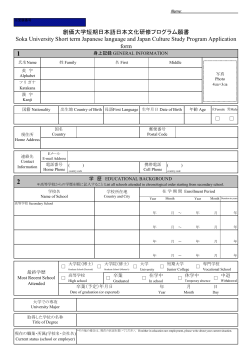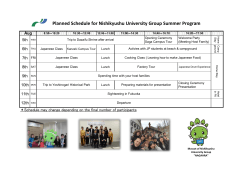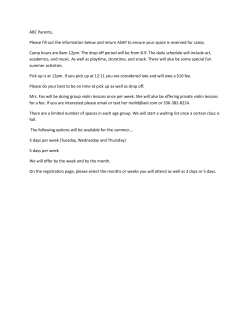
Internment of `enemy aliens` 5.7
5.7 Internment of ‘enemy aliens’ aliens: until 1949 there was no Australian citizenship. Legally Australians — either native born or naturalised — were British subjects. You became a British subject simply by being born in any of the British Colonies or Dominions (Australia and Canada were ‘Dominions’). Anyone else was an alien. internment: the practice of keeping people under guard in a specific area, particularly during wartime As soon as war broke out in 1939 many Australians feared that foreign residents from countries Australia was at war with might act as spies or carry out sabotage activities. In order to monitor these people, the Alien Registrations Act 1939 was passed. Specified aliens had to register with their local police and get permission to travel, and they needed a permit to have radios, binoculars or even carrier pigeons. This Act applied first to those born in Germany but as the war widened it included Italians (June 1940), Japanese (December 1941) and even Indonesians. The government established internment camps to hold these ‘enemy aliens’. The number of residents imprisoned reached a peak in September 1942 with over 7000 people being distributed over 18 camps. Many of the Germans interned had been sent out from England and over half of these were German Jews. From the end of 1943 the main use of the camps was for captured prisoners of war. The largest group of these (14 720) were Italians captured in the Middle East campaign (see pages 172–3), and the rest were made up mainly of Japanese (2223) and Germans (1585). After some time the Italians were not seen as a serious threat. Many had not been willing soldiers in the first place. They often worked on farms outside the camps. However, the Japanese were not as willing to accept defeat (see source 5.43), and in 1944 staged a breakout in a camp in Cowra. SOURCE 5.40 Photograph of two families of German internees taken in Tatura Internment Camp in northern Victoria in March 1945. Parents on the left are Ewald and Anna Glenk and the parents on the top right are Irmgard and Gunther Baden. AWM 030242/13 SOURCE QUESTIONS 1 Deduce why a number was included when the photo in source 5.40 was taken. 2 Do you think these internees have been treated well? Give reasons for your answer. 3 On the Australian War Memorial website (www.awm.gov.au) go to ‘Collections’ and search for Tatura and World War II. There are many photos of the camp there. Identify the photos you would have chosen to give an accurate picture of the camp. Why? CHAPTER 5 | Australia and World War II 191 SOURCE 5.41 Photograph of Australian soldiers marching a large group of Japanese internees to a prison camp SOURCE QUESTIONS 1 In source 5.41, explain what the shadows indicate about the time of the day. 2 Why might this be relevant in understanding the treatment of prisoners in inland Australia? 3 Do the soldiers seem concerned about security? Use evidence from the photo to support your answer. SOURCE 5.42 Photograph of Italian prisoners of war at the Liverpool Internment Camp in New South Wales, 1945. The camp sold firewood and the internees worked in timber cutting as well as blacksmith work and farming. AWM 123717 SOURCE 5.43 An officer of the garrison guarding the Japanese at Cowra wrote as follows. Geneva Convention: an international agreement on the conduct of war, especially on the role of the Red Cross and the treatment of prisoners of war They [the Japanese] did not understand the Articles of the Geneva Convention . . . and our strict adherence to its terms merely amused them and further convinced them of our moral and spiritual weakness. They read into our humane treatment of them a desire to placate them, and this they felt sprang from our secret fear of them. www.awm.gov.au/encyclopedia/cowra/doc.htm SOURCE QUESTION Compare the conditions of the photos in sources 5.40, 5.41 and 5.42 with those of the Australians in Japanese prisoner-of-war camps (see pages 185–6). What are the significant differences? 192 Retroactive 2 The Cowra breakout SOURCE 5.44 A photograph taken near the perimeter wires on the morning after the Cowra breakout The prisoner-of-war camp near rural Cowra was roughly circular in shape, with a diameter of about 700 metres. There was one compound in each of the four segments of the circle, with broad open spaces between them. The Italians were in compounds A and C. Japanese officers, with some Korean and Formosan (Taiwanese) prisoners were in Compound D, and Japanese non-commissioned officers and junior ranks were in Compound B. The uprising took place in Compound B. The camp was considered safe because it was surrounded by three rows of barbed-wire fences and had six tall guard towers around the perimeter. However, by June 1944 the camp was becoming crowded and a Korean prisoner leaked news of a possible breakout. Two Vickers machine guns were brought in and a decision was made to move the Japanese in Compound B further south to Hay. The announcement of this decision prompted the Japanese prisoners in Compound B to act and around 2.00 am on Saturday 5 August 1944 the plans for the breakout were put into action. They divided into four groups: two to storm the perimeter fences, one to attempt to link up with the officers in Compound D, and one to storm the gates. Two privates who manned a machine gun were overwhelmed by the numbers and killed, but Private Ralph Jones was able to disable the gun so that the Japanese could not use it against the Australians. Of about 1000 prisoners, 334 managed to escape and it took nine days to recover them all. Many of the prisoners committed suicide rather than be recaptured. Two threw themselves under a train and many hanged themselves. A total of 231 Japanese were killed and 108 injured. Four Australians were killed and four injured. The Japanese kept their promise not to injure any civilians. SOURCE QUESTIONS AWM 044172 1 From source 5.44 and the text, identify security measures that were in place in the Cowra prisoner of war camp. 2 Why had blankets been thrown across the wire? ACTIVITIES Describe means state what something is like. CHECK YOUR UNDERSTANDING 1 Explain why the Alien Registration Act was introduced in 1939. 2 List the nationalities that were defined as ‘aliens’ between 1939 and the end of 1941. Why were these nationalities chosen? 3 Describe how the use of internment camps changed after 1943. 4 What was the largest group of prisoners of war? Where had they been captured? 5 Where would the German prisoners of war have been captured? 6 What were the Japanese and Australian casualties in the Cowra breakout? 7 Explain why so many of the Japanese escapees committed suicide rather than be recaptured after the Cowra breakout. CHAPTER 5 | Australia and World War II 193
© Copyright 2025









